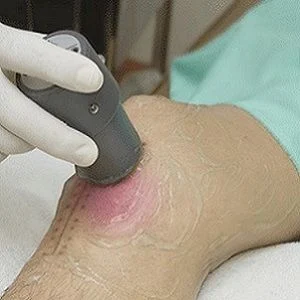Healing times for skin ulcers and bedsores can be reduced by a third with the use of low-intensity ultrasound, according to a pioneering study published in the Journal of Investigative Dermatology. Researchers from the University of Sheffield discovered the ultrasound transmits a vibration through the skin and wakes up cells in wounds helping to stimulate and accelerate the healing process.
In the UK, more than 200,000 patients suffer with chronic wounds every year at a cost of over £3.1 billion to the NHS.
As the ultrasound treatment can also reduce the chance of wounds getting infected, researchers say it is particularly effective when treating diabetics and the elderly. There are 11 million over-65s, three million diabetics, and 10 million smokers in the UK — all of whom are likely to suffer problems with healing wounds.
In addition, about 25 percent of diabetics suffer from skin ulcers, particularly foot ulcers, due to the loss of sensation and circulation in the legs.
"Skin ulcers are excruciatingly painful for patients and in many cases can only be resolved by amputation of the limb," said the study's lead author Dr. Mark Bass, from the University's Centre for Membrane Interactions and Dynamics. "Using ultrasound wakes up the cells and stimulates a normal healing process. Because it is just speeding up the normal processes, the treatment doesn't carry the risk of side effects that are often associated with drug treatments."
Dr. Bass' study was carried out in collaboration with the School of Biochemistry at the University of Bristol, the Wound Biology Group at the Cardiff Institute of Tissue Engineering and Repair, and the orthopaedic company, Bioventus LLC.
"We have found that the ultrasound signal we currently use is effective, but it is possible that by refining the treatment we could improve the effects even further," Dr. Bass pointed out. "Because ultrasound is relatively risk free we could expect to see it in broad clinical use within three or four years."
Source and image credit: University of Sheffield
In the UK, more than 200,000 patients suffer with chronic wounds every year at a cost of over £3.1 billion to the NHS.
As the ultrasound treatment can also reduce the chance of wounds getting infected, researchers say it is particularly effective when treating diabetics and the elderly. There are 11 million over-65s, three million diabetics, and 10 million smokers in the UK — all of whom are likely to suffer problems with healing wounds.
In addition, about 25 percent of diabetics suffer from skin ulcers, particularly foot ulcers, due to the loss of sensation and circulation in the legs.
"Skin ulcers are excruciatingly painful for patients and in many cases can only be resolved by amputation of the limb," said the study's lead author Dr. Mark Bass, from the University's Centre for Membrane Interactions and Dynamics. "Using ultrasound wakes up the cells and stimulates a normal healing process. Because it is just speeding up the normal processes, the treatment doesn't carry the risk of side effects that are often associated with drug treatments."
Dr. Bass' study was carried out in collaboration with the School of Biochemistry at the University of Bristol, the Wound Biology Group at the Cardiff Institute of Tissue Engineering and Repair, and the orthopaedic company, Bioventus LLC.
"We have found that the ultrasound signal we currently use is effective, but it is possible that by refining the treatment we could improve the effects even further," Dr. Bass pointed out. "Because ultrasound is relatively risk free we could expect to see it in broad clinical use within three or four years."
Source and image credit: University of Sheffield
References:
Bass MD et al. (2015) Ultrasonic Stimulation of Mouse Skin Reverses the Healing Delays in Diabetes and Aging by Activation of Rac1. Journal of
Investigative Dermatology, 16 June 2015; DOI: 10.1038/jid.2015.224
Latest Articles
healthmanagement, ultrasound, skin, wound, diabetics, skin healing
Healing times for skin ulcers and bedsores can be reduced by a third with the use of low-intensity ultrasound, according to a pioneering study published in the Journal of Investigative Dermatology.






